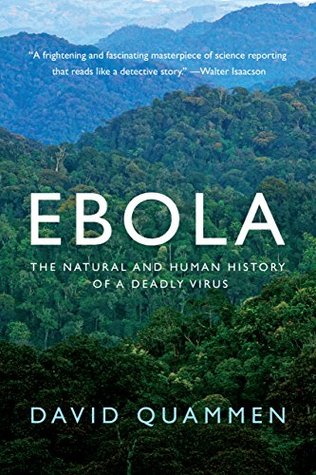Usually by this time I'd be Googling Ebola, or buying a New Scientist with a special set of articles on the subject, but I haven't. But luckily I had a quick browse on NetGalley and came across this book. So I approached this volume hoping that all my curiosities would be quelled; what is Ebola exactly? How is it transmitted? What effects does it have on the body? Where does it hide in it's downtime?
Were my questions answered? Not exactly. But through no fault of the author's at all.
I had no idea how little we know about Ebola.
David starts his new book acknowledging that it is a rehash of a section from his previous book from 2012 'Spillover' that looks at zoonoses or an infection that is transmissible from animal to human. The majority of this book is not new material and is taken heavily from the aforementioned volume, but it has some small sections updated until early September 2014 regarding the new outbreaks. And while cynics will see this as a cash in on a new range of deaths I saw this as being far from it as it was an informative piece of writing that answered all the questions that it could regarding Ebola and introduced me to a writer who I had never read before and will probably go on to read in the near future.
The small book takes us through a short history of Ebola outbreaks ever since the first recorded outbreaks in the 1970s. It is also interspersed with a first hand account from David when he traveled through one region that had previously had outbreaks with a biological survey. So not only was the overview of the history of outbreaks fascinating, but it had personal stories from the people affected inbetween.
But the most astonishing aspect of the disease is how little is known about it for various reasons. When you have a virus that stays dormant for years in a non-human host, and then sudden outbreaks happen in the most remote places of Africa, where there are minimal survivors, and those that are infected die very quickly you have a very hard virus to study. Not only that but it is one of the most deadly viruses known and studies done with samples in laboratories require large amounts of risk minimisation and therefore large amounts of funding. So while a known set of symptoms are present the exact mechanism of how the virus interacts with the body still requires a great deal of work. It is known to devastate the patients immune system and also cause uneven clotting in the cardiovascular system so that clots appear in some areas while other bleed uncontrollably from the slightest rupture say of a needle.
David presents a short volume that is engrossing, horrific and truthful. I have come away with a much greater understanding of the complexities of the situation in these west-African countries and how their political and belief systems are exacerbating the situation. However I also know that the rest of the world could be putting in a greater effort and not dismissing it as yet another plight of the African or having undue panic and believing that it is a sign of the oncoming apocalypse.
Thank you to Netgalley and Random House UK for a copy of this book to review.




No comments:
Post a Comment